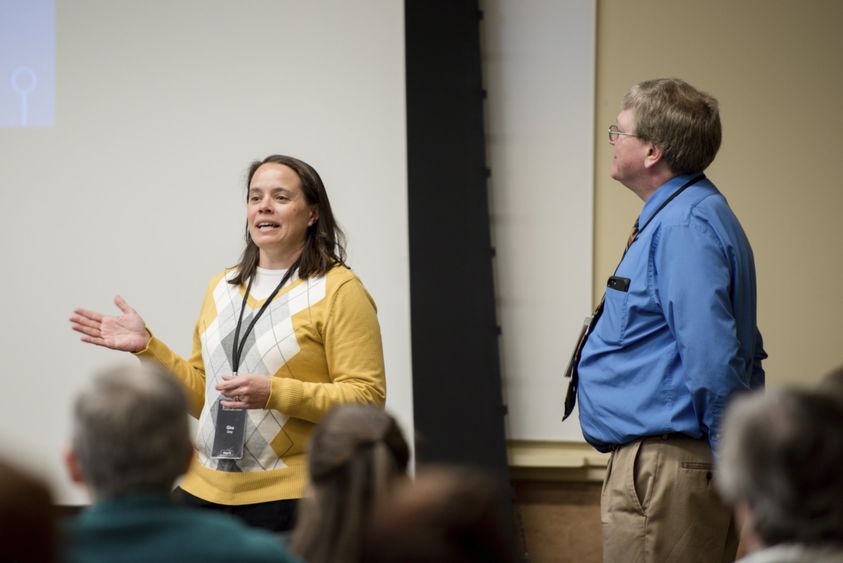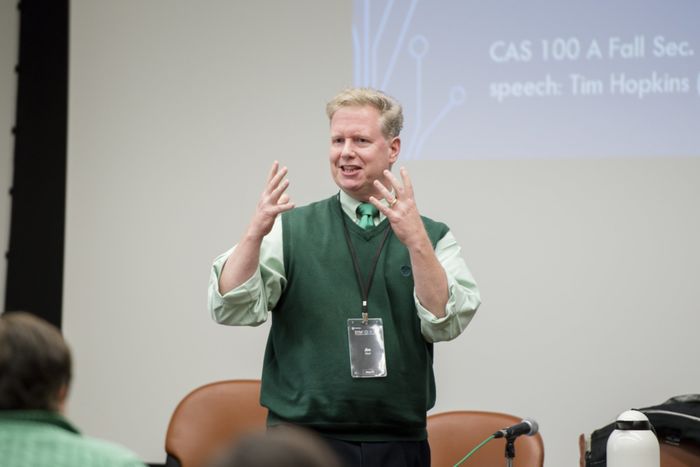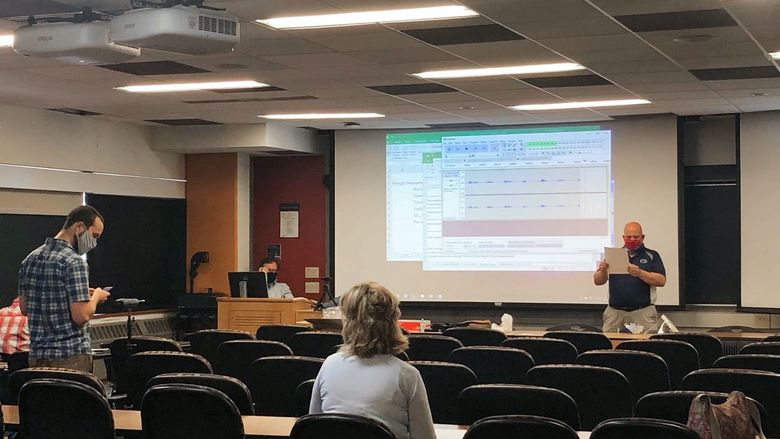
Gina Gray, assistant teaching professor of kinesiology, and Griff Lewis, instructional designer at Penn State Scranton, presented the Swivl project at the 2018 Penn State Symposium for Teaching and Learning with Technology.
A robotic video capture platform is well on its way to transforming kinesiology and speech education at Penn State Scranton.
Previously piloted at other college campuses, including Penn State Berks, there are many uses for the robotic platform known as Swivl. The smart robot turns a tablet or smartphone into a video capture system that will scan a room at command and stop to focus where it is needed.
Instructors at the Scranton campus have explored Swivl's uses by recording students speaking so they may enhance their speech communication skills, and analyze their escape tactics in personal defense situations.
In the kinesiology department, assistant teaching professor Gina Gray has been using the smart robot to give students more opportunities to work on both their physical and verbal strengths and weaknesses. The technology serves as a great tool for a class that is always on the move.
"I do a lot of skill assessment types of things and the video is great to have because that's another source of input for them besides just hearing it from me, then they can actually watch themselves and see how they do," Gray said.
The pilot was funded by the Scranton campus IT budget and spearheaded by campus instructional designer Griff Lewis. The campus has funded a variety of projects involving emerging technologies over the years. Lewis said these pilots have revolved around educational technology such as podcasting and clickers, fulfilling the campus’ mission to continue to provide innovative technologies in the classroom that will enhance students’ learning.
“Swivl and other initiatives like our campus One Button Studio, as well as support of University-wide pilots like Open Educational Resources, enable hybrid courses, providing flexibility for our students,” said Lewis. “Many have jobs, families and other commitments that could prevent them from enrolling in programs; using technology enables flexible, quality instructional delivery. Our students benefit from both the ability to review recorded instruction when their schedule allows, and the feedback provided by recording their own performances in their classes.”
In Gray’s classes, the technology was received positively and proved to be beneficial to the students.
In being recorded through the movable platform, Gray said students in the fall Ultimate Frisbee class were able to have their gameplay recorded, watch videos of their teams, and analyze how they performed basic strategic concepts. Afterward, students would come back to class and implement some changes to the team strategy.
In the spring, Gray recorded students in her Personal Defense class and their interactions with one of the campus police officers, who would play the role of an attacker.
“Then they watched their video and they analyzed, 'Did I have correct posture? Did I use the correct language? Did I use the correct escape techniques?'" Gray explained.
Students in the kinesiology classes said that the use of the Swivl was a good opportunity to allow them to really engage with the course content. In Ultimate Frisbee, students felt that the Swivl helped them engage with each other because they were recorded as a team and had to do a team review.
Future plans for using the smart robot in other kinesiology courses are in the works. Gray said she does have additional activity and sports-based courses in the fall that she may try to use it in to help students build upon their foundational skills.
For instructors in other disciplines, Gray sees the Swivl as a usable technology that does not require advanced technical knowledge.
"It can really be used in any kind of course experience; it doesn't have to be an activity like I'm doing,” she said.
Another instructor at the Scranton campus who has been taking advantage of the technology is Jim Hart, lecturer in arts and humanities, who has been using it in his speech communication classes.
When Hart started teaching more than 20 years ago, VHS tapes were the only way students could record themselves.
"Once VHS started fading out, it became more difficult for me to record the students in the classroom,” he said. “When Griff approached me about this new piece of equipment, I was really excited about it."
During the past fall and spring semesters, Hart used the Swivl in his Effective Speech and Small Group Communication courses. In the Effective Speech course, students used the Swivl to record their initial informative speech and later their persuasive speech.
Upon watching themselves and taking down notes on what could be improved, from how they actually sound to their mannerisms, Hart said that students gave a better speech the second time. Students agreed that the smart robot helped them improve upon their speech skills.
Not only was it beneficial for students in terms of improving their speech communication skills, but the Swivl also definitely helped Hart in the grading procedure.
After watching students give their speeches in class, Hart said he goes back later to watch the recorded speeches. In doing this, he can see if he missed anything during class.
For the coming fall semester, Hart has been approved to continue the pilot in his courses and also will record some of his lectures with the Swivl. He said that he has a class in the fall where he teaches it in both a face-to-face and digital learning format, and he will upload all of his lectures to Box so students can view them on days they don’t need to be in the classroom.
"I love it," Hart said. "Until something else comes down the pipe, hopefully I get to use the equipment as much as possible because I think it's a great learning tool."



